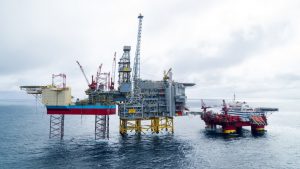Martin Linge officially opened today

Martin Linge in the middle. Maersk Intrepid to the left, Floatel Endurance to the right.
Photo courtesy of Jan Arne Wold & Øyvind Gravås / Equinor.
Minister of Petroleum and Energy, Marte Mjøs Persen, will today, 27 January, officially open the Martin Linge field. With good operational performance since the field came on stream in June and high oil and gas prices, the investments in the field are expected to be recovered in full during 2022.
“Martin Linge has been a very challenging project to put on stream. Thanks to competent colleagues, good suppliers, and good collaboration with our partner Petoro and the authorities, the field was efficiently and safely put on stream last year. The field is now producing very efficiently. With current prices, investments in the field will be recovered in full during 2022”, says Anders Opedal, President and CEO of Equinor.
Since production started on 30 June 2021, Martin Linge has delivered world-class production efficiency for a new field in the start-up phase. “I would like to thank the project and the organisation now operating the field for working hard to realise the project, and to deliver safe and efficient field operations every day”, says Kjetil Hove, Executive Vice President, Exploration & Production Norway. The Martin Linge project encountered significant challenges in the development phase. Capital expenditures in the Martin Linge field totalled USD 7 billion, compared with USD 3.5 billion in the plan for development and operation (PDO) from 2012. The field came on stream in June 2021. Equinor took over the operatorship from Total in 2018.
The expected recoverable resources are about 260 million barrels of oil equivalent. At plateau the field will produce around 115,000 barrels of oil equivalent, mainly gas and condensate. The field is expected to reach plateau production during 2022. Martin Linge is the first platform to be put on stream by Equinor from an onshore control room. The wells and the process are operated from the control room in Stavanger. The offshore operators use tablets in the field to collaborate with the onshore control room and the operations teams onshore. Digital solutions provide early indications of potential failures in the facilities, enabling reduced operational costs and optimalisation of energy consumption. Due to power from shore the emissions from the field are low (about 1 kg of CO2 per barrel)






